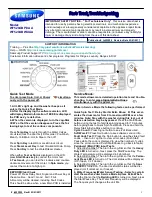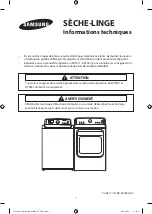
16
wash cycle table
Programme
Cycle Selection
Information
Process
Detergent
Amount
(Pre-wash/
Main wash)
Running
Time
(min.)
Energy
Consumption
(Kwh)
Water
Consumption
(I)
Rinse
Aid
3 In 1
• Pots, utensils
and cutlery.
• Normally soiled
loads.
• Use
multifunctional
detergent.
• Pre-wash
(50°C)
• Wash (55°C)
• Rinse
• Rinse (65°C)
• Drying
• 3 in 1
150
1.08
13.5
Intensive
• Pots, pans,
casserole dishes.
Dishes that have
been sitting with
dried food on
them for a while.
• Heavily soiled
crockery and
normally soiled
pots, pans,
dishes, etc.
• Pre-wash
(50°C)
• Wash (65°C)
• Rinse
• Rinse (55°C)
• Drying
• Pre-wash
(5g)
• Main wash
(22g)
120
1.13
16
Normal
• Pots, plates,
glasses and
lightly soiled
pans.
• Normally soiled.
• Pre-wash
(50°C)
• Wash (55°C)
• Rinse
• Rinse (65°C)
• Drying
• Pre-wash
(5g)
• Main wash
(22g)
155
1.09
13
ECO*
(EN50242)
This is Standard
programme, it is
suitable to clean
normally soiled
tableware and it is
the most efficient
programme in terms
of its combined
energy and water
consumption
for that type of
tableware.
• Pre-wash
• Wash (50°C)
• Rinse (60°C)
• Drying
• Pre-wash
(5g)
• Main wash
(22g)
160
0.77
10.5
1 hour
• For dishes that
need to be rinsed
and do not need
excellent drying
efficiency.
• Lightly soiled.
• Wash (60°C)
• Rinse
• Rinse (50°C)
• Drying
• Main wash
(27g)
60
0.77
10
Glass
• Glasses, crystal
and fine china.
• A shorter wash
for lightly soiled
loads.
• Pre-wash
• Wash (40°C)
• Rinse
• Rinse (60°C)
• Drying
• Main wash
(15g)
95
0.71
13
Rapid
• A shorter wash
for lightly soiled
loads that do not
need drying.
• Wash (40°C)
• Rinse
• Rinse (40°C)
• Main wash
(15g)
30
0.50
9
* To comply with Standards of Performance, i.e. EN50242, please ensure to use economy washing cycle for the test.
Summary of Contents for KDW45S13
Page 1: ...Slimline Dishwasher KDW45S13 installation instructions manual ...
Page 2: ......
Page 35: ......
















































